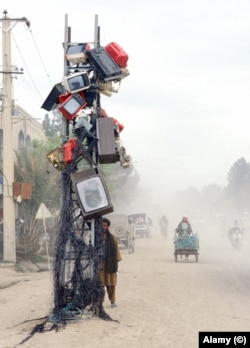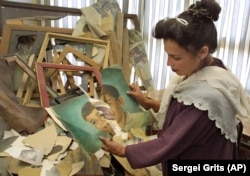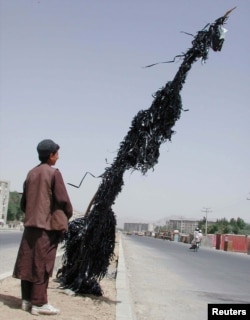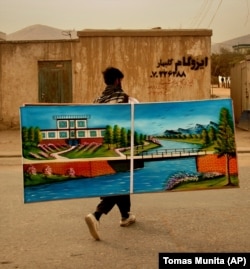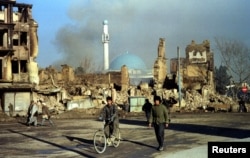A photojournalist who worked in Afghanistan during the Taliban's 1996-2001 rule says the reinstated group's new ban on images of living things is unfeasible today.
In the 1990s, the Afghan photojournalist, who asked to remain anonymous due to his continued links to the country, recalls that “photos were completely prohibited. The Taliban banned it. Even if there was a press conference or something, they said, ‘You cannot take pictures.’”
But during the first Taliban era, in which punishments could be severe for even minor transgressions, taking photos of people was still a regular, risky occurrence for the photojournalist, along with a small number of his fellow Afghans working for Western news agencies.
“We had small cameras, and when we went to do stories we would just go somewhere where there was no more Taliban, and we would take one or two shots, then quickly leave," he says. "It was like a 'stolen picture.'"
During the first Taliban era, he says, the handful of local photojournalists “had to process our film using chemicals. It was very complicated.”
Today, however, “everyone has a phone; it’s digital.”
Additionally, the veteran photojournalist says, “The Taliban themselves like to see Facebook. They have WhatsApp It will be very, very difficult to stop it" since the new generation of Taliban "grew up with the Internet."
The photographer says he was detained several times for taking photos during the Taliban's first rule. One of his colleagues was imprisoned overnight after photographing a man who turned out to be a foreign extremist from an Arab state who leaped up to detain the photographer and took him to the Taliban's "vice and virtue" police.
Some within the Taliban leadership apparently turned a blind eye to the ban on imagery showing living things during the 1990s.
“My pictures were printed many times in a Pakistani newspaper, and the following day the newspaper would be sent from Pakistan to [the Pakistani Embassy in] Kabul,” the photojournalist says. "The Taliban could have called me and asked, ‘Why did you take a picture?’ But this never happened."
But, he adds, “on the ground, it was absolutely not allowed to take photos.”
For ordinary people, indulging in illicit entertainment through the 1990s was a commonplace, if nerve-wracking, experience.
"People would watch TV and listen to music cassettes, but very secretly. They were sitting in the basement or somewhere and completely closing the window," he recalls.
The photojournalist says the second iteration of Taliban rule has been relatively lenient compared to the first, but "little by little, the smell -- the bad smell -- is returning," and referenced the recent shutdown of television stations in northern Afghanistan for screening images of people.
The Taliban leadership in the group's founding city of Kandahar is "very extremist," he says, though some have undoubtedly been changed by what they have seen of prosperity in the outside world -- something the Taliban's first generation of leadership never experienced.
"These Taliban in the past few years have been in Qatar, Iran, Pakistan, India, and they have seen how beautiful the world outside Afghanistan is. When [Taliban founder] Mullah Omar took power [in 1996], they came straight from the madrasahs and took Kabul, but after the civil war it was completely destroyed -- no TVs, no nothing."
This time, the photojournalist says, "the Taliban were handed a beautiful Kabul with construction, beautiful cars, restaurants, buildings. Everything is so superior to what the previous Taliban saw."

